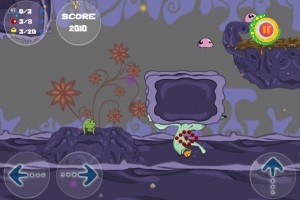The microbial world is no picnic! There’s definitely a pecking order among all the bacteria, protozoa and tardigrades, with the two-legged-no-armed Grash pretty close to the bottom. Troll inc’s Jellyflug (Out Now, $1.99) gives you the task of guiding him through a whimsical odyssey that’ll make you view your kitchen in a whole new light.
 Jellyflug starts out feeling like a pretty run-of-the-mill platformer, but give it a few levels and its environments blossom into some of the best we’ve seen on iOS. Surprises abound: you’ll be moseying along and suddenly a giant miniboss crashes in to give chase, vulnerable only to environmental hazards like stalactites, rocks or vents you’ll have to turn against it. Soap is a constant adversary, sometimes raining down in torrents after events happening in the game’s multilayered backgrounds give you fair warning. Just when you think you’ve reached a dead end at the bottom of a long vertical chute, bubbles will start flowing up to give you a lift. Jellyflug truly matches wits with some of the best level designs the 16-bit era had to muster, and that’s what makes this an important game to look at from a design perspective.
Jellyflug starts out feeling like a pretty run-of-the-mill platformer, but give it a few levels and its environments blossom into some of the best we’ve seen on iOS. Surprises abound: you’ll be moseying along and suddenly a giant miniboss crashes in to give chase, vulnerable only to environmental hazards like stalactites, rocks or vents you’ll have to turn against it. Soap is a constant adversary, sometimes raining down in torrents after events happening in the game’s multilayered backgrounds give you fair warning. Just when you think you’ve reached a dead end at the bottom of a long vertical chute, bubbles will start flowing up to give you a lift. Jellyflug truly matches wits with some of the best level designs the 16-bit era had to muster, and that’s what makes this an important game to look at from a design perspective.
If only the combat system could live up to the level design! You simply tap whatever enemy or object you want to attack and Grash flings a little jelly at it, but the process ends up being more slow and deliberate in practice than you’d ever expect — we need some semi-automatic jelly flinging here! Grash’s jellies are deflected by environments so often, I kept wishing for an Angry Birds-style fling mechanic to see if I could aim better manually. Rather than take joy in the contest of survival, I found myself simply jumping over small enemies in hopes of reaching the next miniboss or other cool surprise.
 Jellyflug puts its premise to good use with power-up microbes Grash can combine with for new abilities, but these are introduced much too sparingly to make up the deficit left by the combat system. The power-ups are also temporary and tailored to let the player pass very specific level segments; a permanent upgrade system resulting in a Metroid-or Mega Man X-style adventure could really up the ante in sequels. Other than some renovation of the combat system, what I’m really looking for in updates is a tutorial level. For now, you have to rely on random load screen hints to find out important details like the link between Grash’s health circle and offensive ability, and the fact that certain collectibles really are worth scouring for because they write entries into the game’s microbe codex.
Jellyflug puts its premise to good use with power-up microbes Grash can combine with for new abilities, but these are introduced much too sparingly to make up the deficit left by the combat system. The power-ups are also temporary and tailored to let the player pass very specific level segments; a permanent upgrade system resulting in a Metroid-or Mega Man X-style adventure could really up the ante in sequels. Other than some renovation of the combat system, what I’m really looking for in updates is a tutorial level. For now, you have to rely on random load screen hints to find out important details like the link between Grash’s health circle and offensive ability, and the fact that certain collectibles really are worth scouring for because they write entries into the game’s microbe codex.
Speaking of the codex, it’s a really nice touch and a total joy to read — it’s great to see real-world factoids and gameplay tidbits meshed together. You also have to appreciate the amount of effort put into animated shorts that detail Grash’s journey from one world – read: area of the house – to the next. Jellyflug’s 2.5D environments breathe with a life of their own and the music is memorably atmospheric. On the aesthetic downside, the dynamic camera sometimes sacrifices clarity to give the player a wide view of the environments; this could stand to be toned down a bit on smaller touchscreens, where Grash and some of the smaller enemies can become truly microscopic.
iFanzine Verdict: Jellyflug is totally worth a look for longtime platforming fans who can appreciate just how good the level design gets. However, you’ll have to be forgiving of an achingly slow and sometimes finicky combat system.


